FIGURES OF VALUE A conversation between Isabelle Graw and Kerry James Marshall
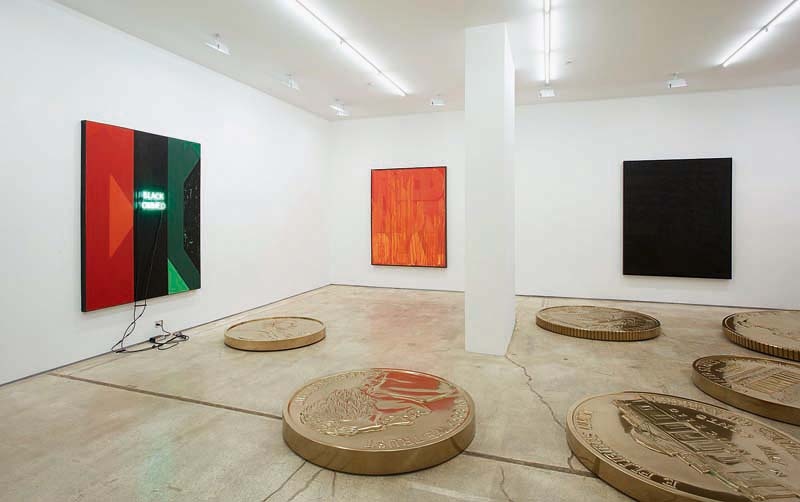
„Kerry James Marshall: Dollar for Dollar“, Jack Shainman Gallery, New York, 2013, Ausstellungsansicht / installation view
ISABELLE GRAW: I thought a lot about your exhibition “History of Painting” (2018). The auction paintings in particular struck a chord with me because I consider them “value reflexive” in two ways: formally and in relation to your own market position. Formally, because they evoke a pop art aesthetic due to the pictorial look of the price tags. Each of them depicts the name of the artist whose work has been auctioned and, more prominently, the amount of money the work sold for, plus a miniature representation of the work itself. The bright colors you use – such as pink and turquoise in History of Painting (May 16, 2009) (2018) – are reminiscent of the signs in a supermarket that announce a product on sale. But one can also understand these paintings as reflecting the market status of your own work. I am, of course, thinking of the record sale of your painting Past Times (1997) to the rapper Sean Combs (P. Diddy) that happened just some months before the “History of Painting” show at David Zwirner in London. Are you reacting against the way your work has ended up in the auction sphere, or are you simply pointing out that paintings turn into commodities, albeit of a special kind, when put up at auction?
KERRY JAMES MARSHALL: Well, it’s all true, except the only thing I would modify is that I’m not reacting against my works being commodified, it’s simply an acknowledgement of the reality that this is a condition that we find pictures in. I think it’s interesting to point this out. On the cover of your book, The Love of Painting, you have this painting by Watteau . . .
GRAW: Yes, Watteau’s L'Enseigne de Gersaint (1720) – a painting that depicts a picture shop that also served as a boutique for luxury items.
MARSHALL: Resistance to acknowledging the inherent commodity formation of paintings, especially easel paintings, doesn’t make any sense to me. I don’t see how people come to the conclusion that somehow painting is different from other sellable goods. If you chart the trajectory of painting up through pop art, through Warhol and Lichtenstein, you understand that they were simply reinforcing the idea that art is part of the commodity stream too, just like everything else. Jeff Koons demonstrated that you can take objects of low status within the marketplace, commonly understood, and transform them into art objects in which the value of the thing increases exponentially, just because it’s now been designated this separate, high-value thing called Art. I’m hyper-aware of all of that, and one of the things I wanted to do with those paintings was simply to point at it again, in real terms. I don’t know if you had a chance to look at my sculpture 99 cent piece (2012)?
GRAW: It was shown at your “Dollar for Dollar” show at Jack Shainman in 2013 – large coins displayed on the floor that seem to programmatically equate artworks with this type of money that relies on a material carrier.
MARSHALL: Yes – if you’re thinking about the trajectory of artworks as commodities, and how you can transform common commodities into artworks, the next step in the logical progression of that idea is not to continue transforming “common” objects into artworks but just to represent the money. One just makes explicit the value exchange by taking the money and making the money itself the artwork. This is a step beyond what Warhol did in simply reproducing the money as image. Instead of taking a cheap commercial object and casting it in stainless steel like Jeff Koons, I decided to just do the money. There were going to be three versions of the work in all the classic modes of sculptural representation: so one would be gilded brass, another, naturalistic, where the coins are all the color that they’re supposed to be . . .
GRAW: This is the version I saw.
MARSHALL: . . . and the third version made in marble. Then you just say, Okay, this is really what it is about. Now, the difference between the production value of the work and the monetary value of the image it depicts, “99 cents,” is amplified. The subtitle of the piece is “One Hundred Thirty-Six Thousand Dollars in Change”; 99 cents is the cheap strata. Beyond that, things start to become expensive.
GRAW: I agree with you that the commodity form is somewhat inherent to art, especially to painting. Easel painting, for instance, was invented in the 16th century mainly for commercial reasons – because it could be easily transported and seemed to be very suitable for commodification. It’s also interesting that you mention Warhol because when I saw 99 cent piece, I immediately thought of Warhol’s Dollar Sign paintings – his extraordinary 200 One Dollar Bills (1962), for instance, which equates painting with money. It reminds us how artworks can function like currency, especially in the highly speculative auction sphere, and how they represent financial value. But Warhol’s dollar bills also operate like figures that retreat or fade away in the silkscreen process. Artworks can’t be reduced to their market value. They consist of symbolic propositions that are supposedly priceless while having a price, of course – a price that depends on the assumption of the pricelessness of their symbolic achievement . . .
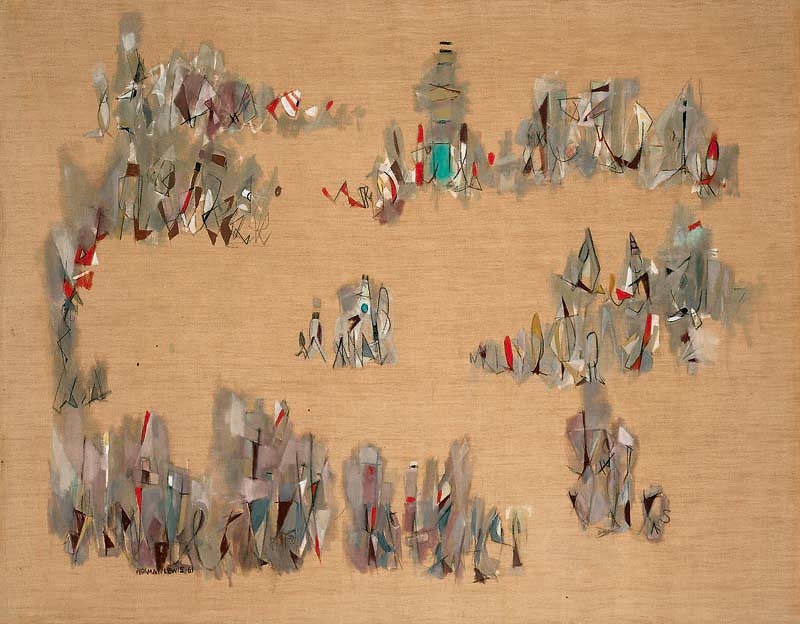
Norman Lewis, „Promenade“, 1961
MARSHALL: Oh, yeah. One certainly has to ask what the difference between artworks and ordinary objects is, beyond the similarities evoked by the readymade. One could say that artworks do more than is necessary but less than what is required. The “more” is how artists change the scale of a thing, the material of it, the texture of it, like Claes Oldenburg did: you take hard things and you make them soft; you take big things and you make them small; you take small things and you make them big. Doing this is more than what is necessary for the representation of the things. But less than is required means a loss of useful function in an ordinary exchange of values. Artworks are not useful tools or appliances. They are not edible. And they are often not very precise. In the case of Warhol, an effect of silkscreening is that every time you squeegee the image, it becomes more degraded. And this aspect of repetition and degradation is what really makes the thing become a work of art. In contrast, the dollar bills they run off at the mint are exactly the same. Their value is certified by how much the same they are to each other.
GRAW: Yes, Warhol’s silkscreened series of dollar bills suggest an equality between art and money while pointing to the differences between them. For me, some of the paintings that were in your “Dollar for Dollar” show display a similar double character and tension: on the one hand, many of these works could be described as linguistic propositions because of their written messages, such as “Why pay more” or “Low low price.” On the other hand, the meaning of these messages is withdrawn – if only because it is often quite hard to decipher them. But, then again, their propositions are repeated (and thus reemphasized) by their titles. For me, these paintings stand for another type of figuration in your work. Next to your paintings that display figures, and thus a morphological type of figuration, these are seemingly abstract paintings that display a rhetorical understanding of figuration that has a long tradition: from Mallarmé and Broodthaers to more contemporary artists like Glenn Ligon or Merlin Carpenter. You paint the letters in quite a bodily fashion, which is why they function like figures asking value-reflexive questions about themselves such as “Why pay more?” This question seems to address the hesitance of buyers to pay more for the work of Black artists. So you also evoke the effects of racial discrimination on the processes of value assignment in these paintings.
MARSHALL: Yes, the letters are treated like figures in these paintings, but the paintings as objects are also treated as we would expect paintings to be treated. Paintings are supposed to be exceptional. These paintings demonstrate all the painterly values too, all the modernist values that often get obscured by the fixation on subject matter. They perform all the codified, modernist functions. They’re supposed to be certain kinds of painting. But they’re also designed to reveal and then conceal whatever meaning the figure is supposed to carry. There’s one titled On Sale Black Friday and it’s a black-on-black painting. It’s more than just two layers: I think there may be three or four layers of meaning that I want people to be able to excavate.
GRAW: Yes, you use the color black, with all its shades and nuances, as a rhetorical device, similar to your figurative paintings. And the title On Sale Black Friday functions like figurative speech once again. In your auction paintings from “History of Painting,” the titles also situate the works historically by including the time and place of each auction.
MARSHALL: Yep. This is because I sort of styled myself a history painter. I am dealing fundamentally with the history painting, what it is, and what it does, which is represent, on a fairly grand scale, selective moments in various histories that everybody is supposed to be familiar with.
GRAW: But for me, your paintings in “History of Painting” also acknowledge on a pictorial level how this claim to represent history “on a fairly grand scale” is difficult, if not impossible, to make nowadays. What we see are fragments of a highly selective choice of auctioned paintings. The depicted sold works that are rendered en miniature like photocopies – there’s nothing heroic or grandiose about them.
MARSHALL: It is a very selective representation of some auctions. If you think about it, auction prices shape many people’s idea of what is important in art. Because every time there’s a high price achieved at the auction house, it’s sometimes the lead story on the evening news. And so, all people know is that this guy named this made a picture that somebody paid this amount of money for. They may know nothing about the thing, about the picture. Most may never ever see it. But they will know that it’s worth this much money.
GRAW: This is why the amount of money paid for the works visually stands in the foreground in your paintings. The works depict how market value gets expressed by the price – a price often misunderstood as standing for the work’s symbolic worth. Both the artist’s name and the price are visually quite prominent in your auction paintings, whereas the depicted artworks look like quantité négligeable, somewhat interchangeable.
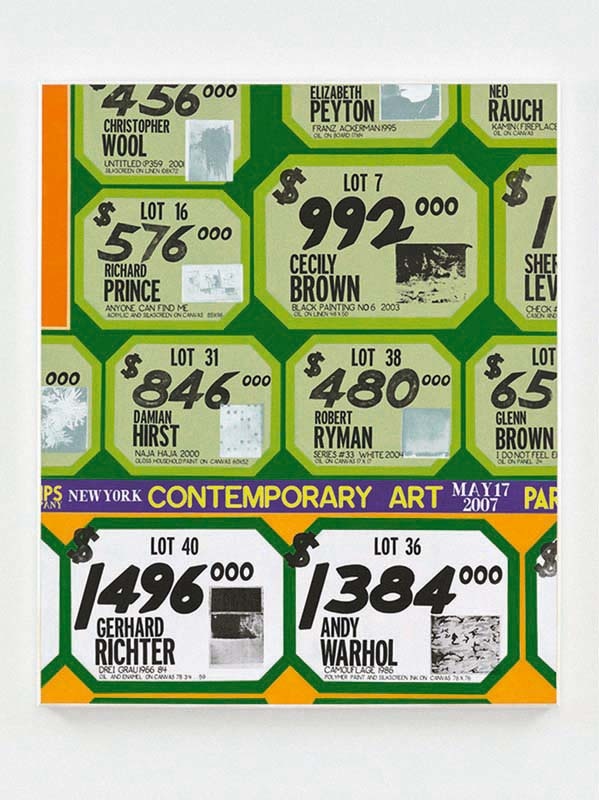
Kerry James Marshall, „History of Painting (May 17, 2007)“, 2018
MARSHALL: Right. I’ll tell you something: When I was young, before I finished school, one of the Jasper Johns flags sold for a million dollars at auction. This was the highest price ever paid for a work by a living American artist. My father saw it on the news, and the first thing he asked me was: “Kerry, when are you going to make a picture that can be sold for a million dollars?” That’s all he wanted to know.
GRAW: So, did you simply want to address how artworks – yours as well – are commodified in the auction sphere? Or did you also want to provoke a kind of mistrust in the value system embodied by auctions?
MARSHALL: You’re not wrong here.
GRAW: It is indeed striking how the names of the artists are depicted like household names in your auction paintings. They remind us of the fact that, in the end, subjects are put on the market because of the importance of singular authors authenticating these works. Thought of in this way, this selling of subject-like products points to the history of racial capitalism and the sale of human beings on the auction block. The term “auction” thus has a particularly negative resonance for Black artists due to the history of slavery. Did you want to allude to this history in these paintings as well, albeit indirectly?
MARSHALL: Indirectly, yes, that’s fair to say, but it also depends on the spectator. The connection is either razor sharp, or it’s pretty blunt and oblique, depending on who sees the pictures. I did make those selections very carefully when I chose whom to include. The one painting with all Black artists in it is from Swann Auction Galleries, History of Painting (February 6, 2007) (2018). Swann is the only auction house that has a designated African American art sale in their lineup – none of the others do. For the longest time, Jean-Michel Basquiat was the only Black artist whose work showed up in elite, mainstream auctions. Later you saw Martin Puryear, Glenn Ligon, and others. But for a time only Basquiat’s work had really high-end exchange value. I very clearly wanted to allude to or point to that as a reality, but there is another dimension of what I was interested in: exchange value is arbitrary on a lot of levels – this is what you label as mistrust. The value of artworks in the Swann auction and the value of the artworks in the Sotheby’s and Christie’s auction houses reflect differences in market stratification. The value of an artwork is, really, only what somebody is willing to pay for it. An artwork only assumes its true monetary value when somebody else pays you more for it than you did. That’s the value auction houses produce: they help shape the exchange value of a thing by locating somebody who is willing to pay more than the introductory sale price. For most Black artists, there have not been a lot of Black collectors willing to do that, even for works by Black artists, before now. The comparatively low value of most of the works by Black artists at Swann is a reflection of that reality. That’s another issue that can be teased out of those pictures.
GRAW: Yes, the gaps in terms of prices are extreme when you compare, say, the Norman Lewis painting auctioned for $67,200 in History of Painting (February 6, 2007) (2018) with the Gerhard Richter for $1,496,000 in History of Painting (May 17, 2007) (2018). The different symbolic and market value assumed for these works is also a symptom of structural racism, especially considering how hugely influential Norman Lewis was for many artists. Your auction paintings also demonstrate how women artists were only allowed into this sphere as “exceptional women” – exceptions were made for artists like Joan Mitchell. And finally, your auction paintings also point to the link between trust and market value: Why does a constellation of trust emerge around the work of some (mostly white and male) artists and not around others?
MARSHALL: Trust is an important factor because everything human beings do is social. It is all structured around a set of premises that everybody sort of builds their expectations around and either knows to be true or believes to be true. Why is one artist’s work considered to be more valuable than that of another? You can ask this question starting from the moment when the excess production of images and objects became structurally formalized. Once art was produced in the service of an elite – whether it was the priesthood, or the aristocracy, or royalty – they determined what was at stake in the production of images. Their ideals got attached to the works as a value that was then internalized and passed down from generation to generation to generation. In the art world, what are we talking about? You also have ideas that drive change and transformation in what is considered good: Why does one artist do one thing and another artist something different? One reason is that they’re trying to draw attention to themselves. That’s just the way it is. From the Renaissance into the 18th, 19th, and 20th centuries, artists were increasingly on their own – the structure of patronage changed. At that time, artists, formerly mere craftsmen, turned into specialists who made things for a luxury market. There was a point – and there probably still is now – where nobody really needs any of the stuff that we’re making.
GRAW: Nobody really needs it, true. Artworks are less “useful” even when compared to luxury items, because a Chanel bag or a Cartier watch at least have use value. But most artworks are not useful in this way – their use consists in the fact that they can’t be reduced to a purpose. They are defined by what they provide symbolically – which goes beyond something that is measurable.
MARSHALL: But this applies only within a narrowly circumscribed domain. Outside the arena in which we think it’s important, none of it really matters. When artists talk about their work, it is always self-serving: we are necessarily interested in advancing our own interests. Our livelihood and our well-being depend on it. So when artists say things about what they do, they will always elevate their particular perception of the good over any other. This is what the whole phenomenon of manifesto writing was all about. It’s like, everything that happened before us, that shit is over, this is what’s real now. That’s what manifestos do. But it has to be based on something. All ambitious artists in the West are desperate to gain attention for themselves. Their strategies are more about disruption than cultural conformity.
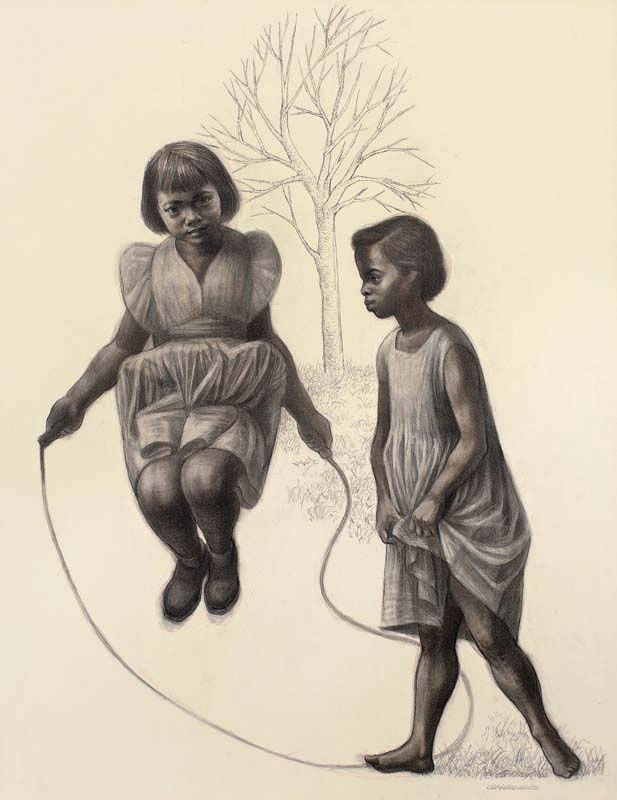
Charles White, „Skipping“, 1960
GRAW: And they aim for producing singularities – artworks that are supposedly unique and provide a difference no other product provides.
MARSHALL: Right. Even if you have to wrap it in lots of illusions – because a lot of it is illusion, of course, even the semblance of difference can be effective. But sometimes there is significant difference even if it doesn’t appear to be so on its face. Conceptual difference can have intrinsic and monetary value too. You said that Norman Lewis was hugely influential – based on what? I don’t think Norman Lewis was hugely influential.
GRAW: Well his work was very important for artists like Jack Whitten, for instance.
MARSHALL: I guess. But to whom is Whitten important? And what function did Lewis’s or Whitten’s work perform for the development of abstract painting?
GRAW: Whitten was an incredibly influential teacher, and for a long time he considered his teaching as an integral part of his work …
MARSHALL: … But that’s a different thing. For a lot of people, whatever teacher they had was hugely influential. So, I say that Charles White was the most influential Black artist in the history of the United States. But that’s partly because I had a particularly close relationship with him and what he did. Even so, I still say he’s more influential, hugely more influential to more people than Norman Lewis or Jack Whitten was. White’s work had everything to do with why I’m using Black figures in my pictures. But I also know I have to distinguish myself from the way White presented his powerful, Black figures.
GRAW: I see two ambitions combined in your figurative paintings, including the “Dollar for Dollar” paintings and the auction paintings: They all inscribe your work quite forcefully into the so-called Western canon and into the history of Black painting at the same time, not allowing one without the other. The value systems associated with these histories are shown to be not isolated from one another, but connected.
MARSHALL: That’s absolutely true. That’s how one could describe what I’m doing as a project. That’s sort of how I see it. And it’s one of the reasons why, again, I would say that the figure is hugely important to me. If you listen to some of the lectures I’ve given, you’ll hear me quote a phrase formulated by W. J. T. Mitchell. It’s become like a mantra for me. He writes, “Images don’t only express our desires, they teach us how to desire in the first place.” This describes my goal as a painter and gives purpose to everything I do. To me, this function of images overrules whatever we think of abstraction, generally speaking, because images teach us how to love things.
GRAW: My take on this quote by Mitchell would be slightly different. While I appreciate his efforts to acknowledge a kind of autonomous or self-acting agency emerging from pictures …
MARSHALL: … He said pictures want to be kissed!
GRAW: Right. But for them to “want” something and to be quasi-alive in this way, there needs to be a viewer who is willing to project that energy or desire onto them.
MARSHALL: Yes, there has to be a spectator, but I’m not going to say that the spectator has to be willing. I think there are images that assert their presence, that impose themselves on the spectator’s consciousness. I think that some images can have this effect. And those are the kinds of images that we are drawn toward: images that don’t just hang around passively waiting for somebody to project onto them, images that do something their makers intend them to do.
GRAW: But an interplay between viewer and work is nevertheless needed – an interrelational kind of operation.
MARSHALL: Yes, but that’s because it’s human beings who made the images.
GRAW: And that’s interesting, because now we come to the figures. I was thinking about how you opt for a positive representation of Black people. You often said yourself that you don’t want to show Black suffering or trauma; rather, you depict your figures in everyday scenes – at home or in situations of leisure. Some of your works made me think of Watteau’s fêtes galantes. But you also never lose sight of the topic of racial discrimination, which does get addressed in shows like “Dollar for Dollar” or “History of Painting.” We are confronted here with a non-equal assumption of artistic importance, with value discrimination when it comes to Black artists. But this happens in your seemingly abstract works, which are highly figurative at the same time, considering that you treat the words or numbers in them like figures. But why do you address discrimination in your seemingly more abstract works?
MARSHALL: I actually don’t differentiate so much between the two kinds of works. For me, they both have, or attempt to have, a similar kind of effectiveness in what they mean to do or how they call the spectator to recognize what’s there. But this other thing about inequality – what’s the remedy for it? I discriminate! For me, not everything is equal. Some things are better than others. The remedy for inequality is not saying, Hey, that’s equal too! I think that the work itself and the project of the work must cause people to recognize its equivalency with other things – it has to create its own equality. Equality is not conferred separately, outside the work. This comes with a set of terms that a lot of people don’t like nowadays, terms like authority. I mean, the work has to have a certain kind of authority.
There are single-celled organisms, and then there are more complex organisms. Artworks can be understood this way too. Some are simple and rudimentary, others complicated, multivalent. We know enough about the operation of images on human psyches to be very deliberate with the use we make of them. Artworks are not mystical enchantments. I think of artworks as things you build.
GRAW: I agree that artworks are produced, often quite deliberately. But I don’t believe that it is the work in itself – the authority it establishes – that ensures that it gets treated equally. The worth of an artwork doesn’t only depend on what it proposes, it also depends on unequal social systems and discriminating structures that manifest themselves in a collective desire that considers a work to be either relevant or not. But I also agree with you that strong authoritative claims have to be made, like when you selected Faith Ringgold in History of Painting (February 6, 2007) (2018) and thereby insisted that her work is part of the canon. You made an authoritative claim, a value judgment, so to speak.
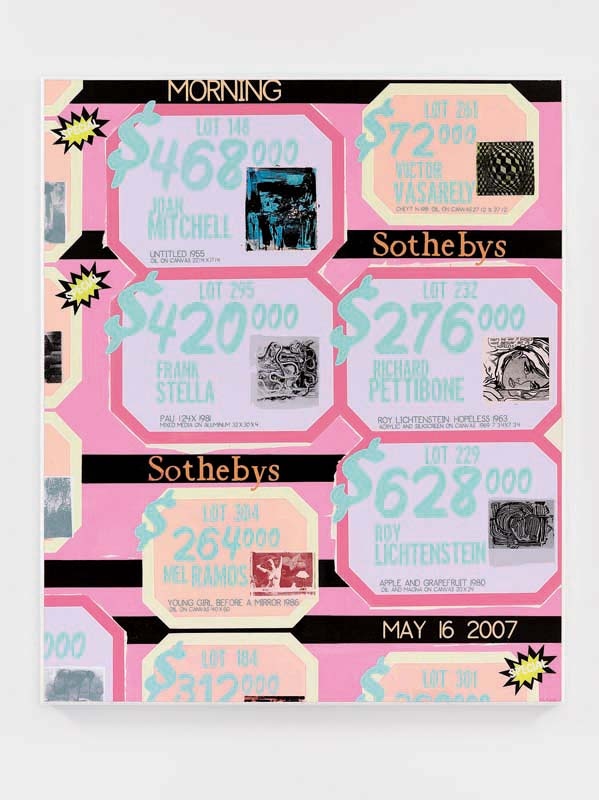
Kerry James Marshall, „History of Painting (May 16, 2007)“, 2018
MARSHALL: To select someone – that’s a value judgment right there. It means that the person is considered important enough to be acknowledged in these terms. It is important to realize that you can do something about the value of the Faith Ringgold work. If you think that it is undervalued in relationship to other things, you can do something about it now. The moment somebody calls your attention to a thing, then the thing becomes available. And then you can act on it. But if nobody ever calls your attention to it, you can’t do anything about it. And you don’t ever have to consider it.
GRAW: Faith Ringgold’s work gets acknowledged and presented for further consideration in your work. But couldn’t one also say that by pictorially privileging the name of the artist and the price of her painting, and by making her work look like a miniature, photocopied version of it, you reproduce the way the auction world functions, which tends to downplay symbolic value while privileging prices? Don’t your auctions paintings run the risk of repeating this pattern a little bit?
MARSHALL: Well, maybe. But that’s a kind of chicken-and-egg construction, like, which comes first? Do people really see the symbolic value of an object after they’ve been introduced to it as a fantastical, high-priced thing? Do they ever really see what’s there? I don’t know. Maybe, maybe not.
GRAW: They might be more willing to take the works more seriously and to look at them more carefully.
MARSHALL: Yeah, they might be more willing, but I know of more than a few collectors who have hundreds of pieces of artwork in their collections, houses overstuffed with things, but they don’t have a clue about what most of it is.
GRAW: While it is certainly true that symbolic achievements of artworks are not thoroughly debated in the auction sphere, they do matter in the long run – also for the market value to be based on something. In the long term it does matter whether an artist has been supported by other artists, critics, or art historians of their time. But in the short term, it is possible that those artworks that reach very high market values have not been supported by experts.
MARSHALL: That’s partly true. But there is a kind of competition among people who generate ideas, too.
GRAW: Yes, they compete in the “market of knowledge.”
MARSHALL: That’s a market too, right? Different types of economies drive the art world. Some artists claim to make unsellable things. When I was in art school at Otis in the mid-1970s, this notion of the artwork as commodity, as an object that can be sold, was very much challenged by conceptual art. The immaterial idea of art is one of the founding principles of conceptual art. Its mission is to undermine the commodity function of artworks. But those artists want to make a living too; they want to be recognized too. The economy in which those artists made their living was in the academy, competing for grants. It’s not that different. There are still judgments being made on the fundamental quality of thinking that goes into their proposals.
GRAW: Some of the artists associated with early conceptual art or institutional critique charge very high prices when they give talks. Or they do real estate business on the side.
MARSHALL: That’s because everybody’s got to live.
GRAW: Exactly. Considering that your work is symbolically and financially very successful, do you feel a sense of solidarity toward Black artists who are not as successful?
MARSHALL: I don’t know any Black artists doing exceptional work who have been overlooked. There are some mediocre Black artists enjoying more than they are due.
GRAW: I don’t agree that all those who do “exceptional” work are recognized. On the contrary, I know many Black and white artists who don’t get the institutional recognition and market success their work deserves.
MARSHALL: But nothing is “supposed” to be any particular way. Nobody is entitled to attention, nobody! Because of my success, I’ve been able to bring people into positions that I wouldn’t have been able to had I not had this success. I’ve also created opportunities and supported other artists. But solidarity is a different issue from deserving success. As a person who makes things, I need a frame of reference that makes what I do legitimate and worth my while. I have to know that whatever I’m doing has a chance to compete against anything else that’s being done. I have to have some way of knowing that I’m getting it right now. This is something one has to do, mostly, alone. If I don’t have that, then I don’t have anything really. And I can’t do anything for anybody else if I don’t have that.
GRAW: I wanted to talk with you briefly about one painting that was shown in the “Dollar for Dollar” show. I’ve only seen it in a reproduction, but it intrigued me. It’s called Red Hot Deal. To me, it looked like a Morris Louis Veil painting in bright orange and red. Once again, it seems to cover up its linguistic proposition. The red evokes something figurative – the body, flesh, the human figure. Are you referring to the “hot deals” that are possible when human figures are depicted in works of art? For me, this is a very corporeal, fleshy painting, as if it’s compensating for the fact that no literal figures appear in it.
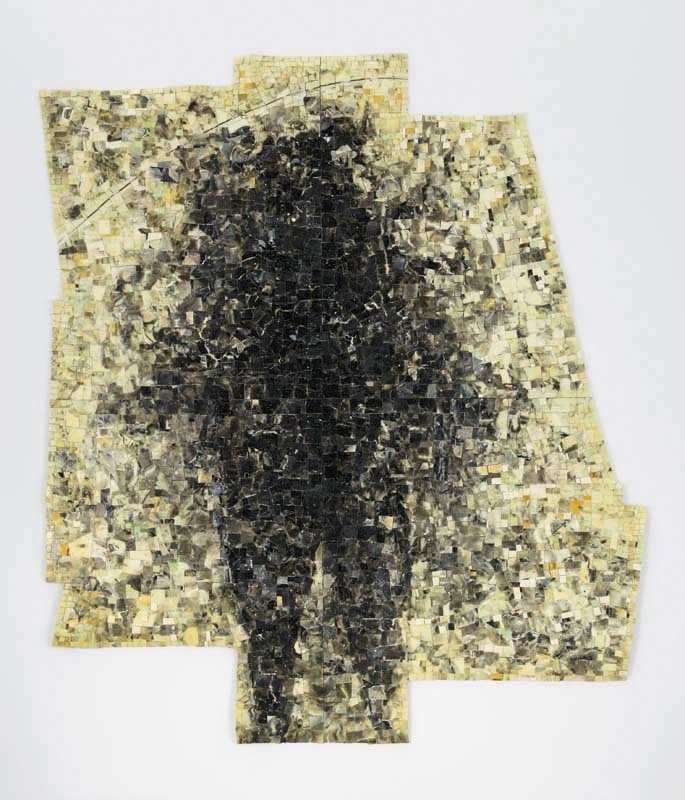
Jack Whitten, „Natural Selection“, 1995
MARSHALL: We could talk about a couple of things here. You were talking about the way in which figures operate in my pictures before – how there’s a kind of positivist spin, no trauma and suffering. At the same time, I can’t be unaware of the fact that painting figures puts images of Black people on the market to be sold. All of those aspects go into my thinking when I’m doing the work; they drive the way I construct the character or the figures that I paint. Even when the figures are literally absent, they’re still present in that sense. I understand the way the art market works: the people who have the most capital to spend on things like artworks are likely to be white, especially at the high end of the market – that’s just the reality. So I’m particularly concerned with the kind of figures that I present. This is why I would make a statement like “I don’t do trauma,” “I don’t do abject imagery,” “I’m a history painter.” I read a lot about the history of Black people worldwide. Tragic and problematic narratives are too easy to exploit. I work slowly and build things up precisely because I want to think through as many aspects of my subject as I can. I want there to be something to excavate if people want to spend the time doing it. But I also recognize that sometimes the first level on which people encounter the work is going to be sensual. What you describe as bodily fluids could be the case. It is kind of bloody looking. But it’s also like heat, flames.
GRAW: I experienced Red Hot Deal as somewhat psychedelic.
MARSHALL: Yeah, there’s a little bit of all of that. But this is the other thing: I believe that I’m a fairly complex human being. I’m operating in all of those dimensions, or privileging one or the other in any moment. It’s all the product of the same consciousness: mine.
GRAW: The person in the product …
MARSHALL: … Yeah, it’s all me. And I try to make sure that all of who I am is present in the work. I try to address Black subjects as objects and as spectators. But I’m equally interested in what you do, the level of engagement you have as a historian and critic – I’m interested in that too. It is as important for people who make things to read and understand what you do as it is to express some internal urge motivated from within one’s own psychology. It seems like a lot of what inflames the argument between figuration and abstraction, between modernism and tradition, is a misunderstanding of motives. These lingering issues are also attempts by artists to reckon with the platonic idea that artists are nothing but charlatans. They’re playing games with shadows. Trickery. It’s all for fun.
GRAW: And they are, right?
MARSHALL: And they are!
GRAW: I was just thinking, it’s very kind of you to consider my work as equally important, but let’s not lose sight of the fact that what I produce, reproducible essays or books, is worth much less in monetary terms than a unique painting.
MARSHALL: But they don’t operate in quite the same system of exchange. I mean, you could probably convert what you do into songs and maybe become a singer, and you might make more money.
GRAW: Since I love singing, I will try it out and let you know if it works! I was very intrigued by what you said about your being very conscious about producing Black figures that circulate on a market mostly dominated by white collectors. Could you elaborate on how, exactly, you prepare your paintings for this circulation?
MARSHALL: The figures I paint are all constructed. They are fabricated ideals. I’m not hiring people to come in and pose there while I paint them black. I make the figures that I want to see in pictures. I told somebody recently that the figures I make were born Black. I don’t alter anybody’s complexion to suit my purpose. I mean for their presence to perform a certain way within the picture. There are a couple of other things I don’t do apart from not representing the abject condition or figures in trauma: I also try to avoid making my figures ornamental, one decorative object among other decorative objects. I try to make sure the characters seem self-possessed, that they have a psychology of their own that isn’t dependent on the spectator’s projection. I don’t paint zombies. They aren’t ciphers. If they stand for a larger concept, it is the fact of Blackness. And yet, every one of them is different from every other one.
GRAW: There’s a certain self-reflexivity built into them.
MARSHALL: Yes. It’s always about being in a picture. When you encounter Black figures in a picture, the question must be: What are they doing there? I always ask this question about my pictures. And why are they available to be looked at? Are they self-aware?
GRAW: They are aware of the fact that they are onstage.
MARSHALL: Absolutely. That’s very important. And it’s not only an awareness of being onstage. Their gaze often points toward someplace outside the frame, toward their own private engagement.
